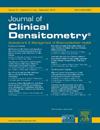2型糖尿病的骨小梁评分:最新的系统回顾和荟萃分析
IF 1.6
4区 医学
Q4 ENDOCRINOLOGY & METABOLISM
引用次数: 0
摘要
背景:骨小梁评分(TBS)可独立预测糖尿病骨病。许多研究比较了糖尿病患者和非糖尿病患者的TBS,结果不一致。在考虑性别和其他混杂因素的情况下,我们进行了一项系统回顾和荟萃分析,以评估2型糖尿病(T2DM)患者的TBS,并阐明其作用。方法:系统检索相关研究,直到2024年10月,使用多个数据库的相关术语。采用RevMan Web和R软件进行统计分析。meta分析采用随机效应模型和反方差统计方法;结果表示为平均差异(MD),置信区间为95% %。研究的主要终点是T2DM组和非糖尿病组之间TBS的MD(未调整或调整)。结果:分析了27项研究的16,354名受试者的数据。与未患糖尿病的对照组相比,T2DM患者在性别组合组中表现出较低的未调整TBS (MD -0.10 [-0.18, -0.02], P = 0.01),男性(MD -0.02 [-0.04, -0.00], P = 0.02)和女性(MD -0.05 [-0.07, -0.03], P <; 0.0001)。T2DM患者的调整TBS在性别组合组中也较低(MD -0.16 [-0.24, -0.08], P <; 0.0001),男性(MD -0.02 [-0.04, -0.00], P = 0.02),女性(MD -0.04 [-0.06, -0.02], P = 0.0005)。在所有三组中,T2DM患者的腰椎骨密度(BMD)均高于非T2DM患者,但女性和两性混合组的髋部骨密度(BMD)较高;股骨颈骨密度仅在性别混合组较高。结论:根据这项最新荟萃分析分析的数据,T2DM似乎对TBS有不利影响,尽管对BMD有积极影响;然而,证据水平非常低。有必要进行更大规模和更长期的研究,以探索涉及的因素和潜在的补救策略。普洛斯彼罗注册号:CRD42024608004本文章由计算机程序翻译,如有差异,请以英文原文为准。
Trabecular Bone Score in Type 2 Diabetes Mellitus: An Updated Systematic Review and Meta-Analysis
Background: Trabecular bone score (TBS) independently predicts diabetic bone disease. Many studies have compared TBS in those with and without diabetes, showing inconsistent results. We conducted a systematic review and meta-analysis to evaluate TBS in type 2 diabetes mellitus (T2DM) and clarify its role, considering gender and other confounders.
Methodology: Relevant studies were systematically searched until October 2024 using related terms across multiple databases. RevMan Web and R software were employed to conduct statistical analyses. Meta-analyses utilized random-effects models and the inverse variance statistical method; results were expressed as mean differences (MD) with 95 % confidence intervals. The primary outcome of interest was the MD in TBS (unadjusted or adjusted) between the T2DM and non-diabetes groups.
Results: Data from 27 studies with 16,354 subjects were analyzed. Compared to controls without diabetes, subjects with T2DM exhibited lower unadjusted TBS in the combined sex group (MD -0.10 [-0.18, -0.02], P = 0.01), as well as in men (MD -0.02 [-0.04, -0.00], P = 0.02) and women (MD -0.05 [-0.07, -0.03], P < 0.0001). Individuals with T2DM also had a lower adjusted TBS in the combined sex group (MD -0.16 [-0.24, -0.08], P < 0.0001), men (MD -0.02 [-0.04, -0.00], P = 0.02), and women (MD -0.04 [-0.06, -0.02], P = 0.0005). While lumbar spine bone mineral density (BMD) was higher in individuals with T2DM than in those without across all three groups, total hip BMD was higher in women and the combined sex group; femoral neck BMD was higher only in the combined sex group.
Conclusion: According to the data analyzed in this updated meta-analysis, T2DM appears to adversely affect TBS, despite having a positive effect on BMD; however, the evidence level is very low. Larger and longer-term studies are necessary to explore the implicated factors and potential remedial strategies.
PROSPERO registration number: CRD42024608004
求助全文
通过发布文献求助,成功后即可免费获取论文全文。
去求助
来源期刊

Journal of Clinical Densitometry
医学-内分泌学与代谢
CiteScore
4.90
自引率
8.00%
发文量
92
审稿时长
90 days
期刊介绍:
The Journal is committed to serving ISCD''s mission - the education of heterogenous physician specialties and technologists who are involved in the clinical assessment of skeletal health. The focus of JCD is bone mass measurement, including epidemiology of bone mass, how drugs and diseases alter bone mass, new techniques and quality assurance in bone mass imaging technologies, and bone mass health/economics.
Combining high quality research and review articles with sound, practice-oriented advice, JCD meets the diverse diagnostic and management needs of radiologists, endocrinologists, nephrologists, rheumatologists, gynecologists, family physicians, internists, and technologists whose patients require diagnostic clinical densitometry for therapeutic management.
 求助内容:
求助内容: 应助结果提醒方式:
应助结果提醒方式:


